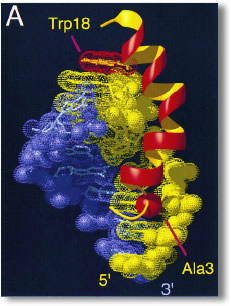
Transcriptional Regulation
Many
proteins have been implicated genetically or biochemically in the regulation
of elongation and termination by RNA polymerase II (RNAPII) in the yeast Saccharomyces
cerevisiae. To identify the subunit composition of these proteins as they
exist in vivo, we have modified chromosomal genes, tagging the carboxyl termini
of subunits of these complexes with protein A and a calmodulin-binding peptide.
We then purified the complexes on immunoglobulin G and calmodulin columns
and identified subunits by matrix-assisted laser desorption/ionization-time
of flight (MALDI-ToF) mass spectrometry and tandem electrospray mass spectrometry.
We found the elongator complex, previously shown to be associated with elongating
RNAPII and thought to have three subunits encoded by the Elp1, -2, -3 genes,
to have six subunits that are dissociated into two three-subunit complexes
at high salt concentrations. Spt4 was associated with three phosphoisoforms
of Spt5 in the complex known as DRB-sensitivity-inducing factors (DSIF) in
humans, but Spt5 was also associated with Spt6 in a different complex. We
found that Spt6 exists in three phosphoisoforms and in three different assemblies:
as a free polypeptide; in association with Spt5; and in association with another,
essential polypeptide of unknown function. We found Spt16 and Pob3, which
were known to associate with histones and regulate both RNAPII and DNA polymerase
a, to associate in humans only with each other, in the form known as FACT
(facilitates chromatin transcription), when purified at high salt concentrations.
When purified at more physiological salt concentrations, Spt16 and Pob3 were
associated with histones, the elongation factor Rtf1, three polypeptides known
to associate with RNAPII, and other polypeptides of unknown function. These
and similar experiments with protein complexes that control termination by
RNAPII, as well as cleavage and polyadenylation, indicate that the factors
that control elongation and termination by RNAPII in vivo sometimes have multiple
forms and are usually multisubunit complexes that easily become disassembled
during multicolumn purification procedures.
[Back to the top]
© 2002 Greenblatt Lab
